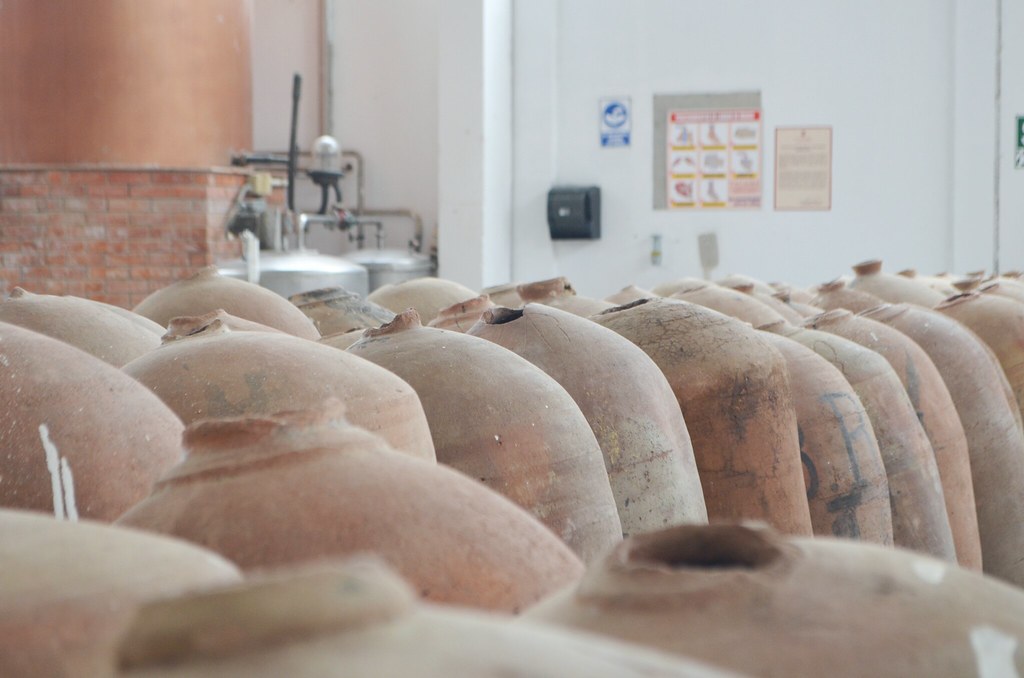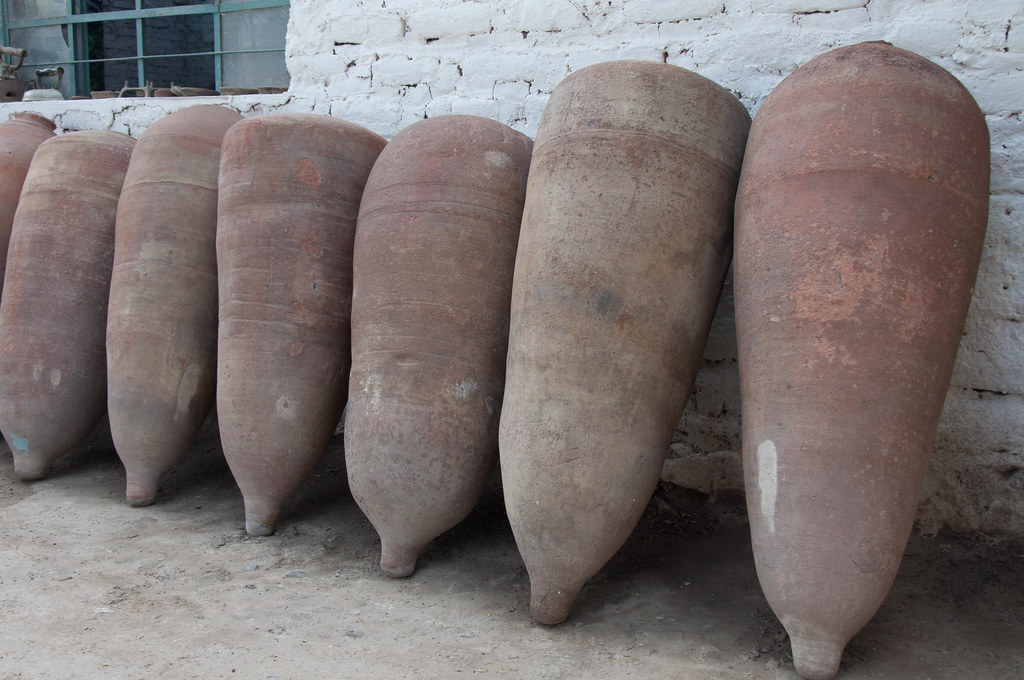Botijas, also known as "tinajas," are large clay pots used for storing liquids or dry goods. They have been used for centuries in Spain, Portugal, and other Mediterranean countries.
Botijas are typically made of red clay and are fired at a high temperature. They come in a variety of sizes, from small jars to large vats. Botijas are often decorated with intricate designs, and they can be glazed or unglazed.
Botijas are used for a variety of purposes, including storing water, wine, oil, and grain. They can also be used as fermentation vessels for making wine or vinegar.
Botijas are an important part of the cultural heritage of Spain and Portugal. They are often used in traditional festivals and celebrations.
The History of Botijas
The Uses of Botijas
The Cultural Significance of Botijas
Botijas
Botijas, also known as "tinajas," are large clay pots used for storing liquids or dry goods, playing a significant role in cultural heritage and practical applications.
- History: Centuries-old tradition in Mediterranean countries
- Materials: Red clay, fired at high temperatures
- Sizes: Range from small jars to large vats
- Decoration: Intricate designs, glazed or unglazed
- Uses: Storing water, wine, oil, grain, fermentation
- Cultural: Part of Spanish and Portuguese heritage, used in festivals
- Practical: Effective storage and fermentation vessels
- Variations: Regional variations in shapes and sizes
Botijas represent a fusion of art and functionality. Their historical significance and diverse uses highlight their importance in Mediterranean cultures. From storing essential liquids to serving as decorative elements, botijas showcase the creativity and practicality of traditional craftsmanship.
History
The centuries-old tradition of using botijas in Mediterranean countries is deeply rooted in the region's history and culture. Botijas have been used for storing and transporting liquids and dry goods for centuries, playing a vital role in everyday life. In ancient times, they were used to store wine, oil, and water, and were essential for preserving food and drink in a region where temperatures can be extreme.
The traditional methods of making botijas have been passed down from generation to generation, and the skills involved in their creation are still highly valued today. Botijas are typically made from local clay, which is shaped by hand and fired in a kiln. The resulting pots are strong and durable, and can last for many years.
Today, botijas are still used in Mediterranean countries for a variety of purposes. They are often used to store wine, olive oil, and other traditional products. They are also used as decorative pieces, and can be found in homes, restaurants, and other public spaces.
The centuries-old tradition of using botijas in Mediterranean countries is a testament to their practicality and durability. These traditional pots are an important part of the region's cultural heritage, and continue to be used in everyday life today.
Materials
The materials used in the construction of botijas play a crucial role in determining their properties and performance. Red clay, fired at high temperatures, is the traditional choice for crafting these vessels, and this combination offers several advantages:
- Durability: Botijas made from red clay are highly durable and can withstand everyday use and exposure to the elements. The high firing temperature vitrifies the clay, making it less porous and more resistant to cracking and breakage.
- Thermal insulation: The thick walls of botijas, combined with the insulating properties of red clay, provide excellent thermal insulation. This helps to keep the contents of the botija at a stable temperature, making them ideal for storing liquids and food.
- Water resistance: Botijas are naturally water-resistant, thanks to the non-porous nature of fired clay. This makes them suitable for storing liquids without the risk of leakage or spoilage.
- Aesthetics: Red clay gives botijas a distinctive and earthy aesthetic appeal. The natural variations in the clay's color and texture add to their charm and make each piece unique.
The combination of durability, thermal insulation, water resistance, and aesthetic appeal makes botijas made from red clay, fired at high temperatures, an ideal choice for storing and transporting liquids and dry goods.
Sizes
The wide range of sizes for botijas, from small jars to large vats, is a defining characteristic that contributes to their versatility and practicality. The varying sizes allow for diverse applications and cater to different storage needs.
Small botijas, often referred to as "botijos," are commonly used for storing and transporting water. Their compact size makes them easy to carry and handle, ensuring hydration during work or travel. Their ability to keep water cool through evaporation adds to their functionality in warm climates.
Medium-sized botijas are suitable for storing liquids such as wine, oil, and vinegar. They are also used for fermentation processes, as their shape and size promote controlled temperature and gas exchange. The non-porous nature of fired clay prevents contamination and preserves the quality of the stored liquids.
Large botijas, known as "tinajones," are impressive vessels used for storing large quantities of liquids or dry goods. They are often found in traditional homes, wineries, and warehouses. Their size allows for bulk storage and contributes to the preservation of contents over extended periods.
Overall, the range of sizes in botijas enhances their functionality, making them adaptable to various storage requirements. Their ability to accommodate different capacities and purposes underscores their importance as versatile and practical vessels.
Decoration
The intricate designs and the choice between glazed or unglazed finishes are significant aspects of botijas, enriching their functionality and aesthetic appeal.
The intricate designs, often featuring traditional patterns and motifs, serve multiple purposes. Firstly, they enhance the visual appeal of botijas, making them decorative pieces that complement various settings. Secondly, the raised patterns and textures provide a better grip, making it easier to handle and transport the vessels.
The option of glazed or unglazed finishes further adds to the versatility of botijas. Glazed botijas have a shiny, smooth surface that makes them easier to clean and maintain. The glaze also creates a protective layer, enhancing the durability and longevity of the vessel. Unglazed botijas, on the other hand, have a more rustic appearance and are better suited for storing dry goods or items that require aeration.
Understanding the connection between decoration, finishes, and the functionality of botijas is crucial for their proper use and care. By choosing the right design and finish, users can optimize the performance and longevity of these traditional vessels.
Uses
Botijas, traditional clay pots, have a long history of serving diverse storage purposes. Their unique characteristics make them ideal for preserving and storing a variety of liquids and dry goods.
- Water Storage: Botijas are highly effective for storing water, particularly in regions with limited access to clean water sources. Their non-porous nature prevents contamination and keeps water fresh for extended periods.
- Wine Storage: The ability of botijas to maintain a stable temperature and humidity level makes them suitable for storing wine. Their use in winemaking dates back centuries, and they continue to be used by traditional winemakers.
- Oil Storage: Botijas are commonly used to store olive oil and other cooking oils. The clay absorbs any impurities, resulting in better oil quality and preservation.
- Grain Storage: Botijas provide a dry and pest-resistant environment for storing grains, such as wheat, rice, and barley. Their ability to regulate moisture levels helps prevent spoilage and maintain the quality of the grains.
- Fermentation: Botijas are also used as fermentation vessels for making traditional alcoholic beverages, such as wine and vinegar. Their shape and size promote controlled fermentation and contribute to the development of complex flavors.
The diverse uses of botijas highlight their versatility and practicality. Their ability to store and preserve a wide range of liquids and dry goods makes them an essential tool in households, wineries, and traditional food production.
Cultural
The deep cultural significance of botijas in Spain and Portugal is evident in their use in traditional festivals and celebrations. These festivals showcase the rich heritage and folklore associated with these vessels.
- Symbol of Cultural Identity: Botijas serve as symbols of Spanish and Portuguese cultural identity. Their presence in festivals represents a connection to the past and a celebration of traditional values.
- Traditional Water Carriers: In many festivals, women carry water-filled botijas on their heads, reenacting the traditional role of women as water carriers in rural communities.
- Decorative Elements: Botijas are often adorned with intricate designs and colorful decorations, adding a festive touch to celebrations. They are used to decorate streets, plazas, and homes during festival times.
- Musical Instruments: In some regions, botijas are transformed into musical instruments, such as drums or percussion instruments, adding a unique rhythm to festival music.
The use of botijas in Spanish and Portuguese festivals highlights their cultural significance beyond their practical applications. They embody the spirit of tradition, heritage, and community, enriching the cultural landscape of these countries.
Practical
The practical significance of botijas lies in their effectiveness as storage and fermentation vessels. Their unique design and material properties contribute to their functionality and make them suitable for a wide range of applications.
Botijas are effective for storing liquids and dry goods due to their non-porous nature and ability to maintain stable temperatures. The thick clay walls provide insulation, helping to keep contents cool or warm as needed. This makes them ideal for storing water, wine, oil, and other perishable items. The non-porous surface prevents contamination and spoilage, ensuring the preservation of stored goods.
Botijas also excel as fermentation vessels, particularly for making traditional alcoholic beverages like wine and vinegar. Their shape and size promote controlled fermentation, allowing for the development of complex flavors and aromas. The clay material absorbs impurities, resulting in a cleaner fermentation process and higher quality end product. Additionally, the ability to regulate temperature and humidity levels within the botijas contributes to the success of the fermentation process.
Understanding the practical applications of botijas as effective storage and fermentation vessels is crucial for their proper use and care. By harnessing their unique properties, users can optimize the preservation and fermentation of various liquids and goods, contributing to traditional food production and cultural practices.
Variations
The regional variations in shapes and sizes of botijas reflect the diverse cultural influences and practical needs of different regions. These variations showcase the adaptability and versatility of botijas, allowing them to fulfill various storage and fermentation purposes.
In Spain, for instance, botijas from the Andalusian region are typically tall and narrow, designed to fit into tight spaces and facilitate pouring. In contrast, botijas from the La Mancha region are wider and shorter, providing ample storage capacity for wine.
Understanding the regional variations in botijas is crucial for their effective use. Matching the shape and size of a botija to its intended purpose ensures optimal performance. For example, a tall and narrow botija is better suited for storing liquids that need to be poured frequently, while a wider and shorter botija is more suitable for storing large quantities of dry goods.
Moreover, regional variations in botijas contribute to the preservation of local traditions and cultural heritage. Each region's unique style of botija reflects the skills and creativity of its artisans. By embracing these variations, we celebrate the diversity and richness of traditional craftsmanship.
Botijas
This section provides answers to common questions and misconceptions surrounding botijas, traditional clay vessels used for storage and fermentation.
Question 1: What are botijas?
Botijas are large clay pots with a long history of use in Mediterranean countries. They are typically made from red clay fired at high temperatures, and their sizes can range from small jars to large vats.
Question 2: What are the benefits of using botijas?
Botijas offer several benefits, including their durability, thermal insulation, water resistance, and aesthetic appeal. They are well-suited for storing liquids and dry goods, and can help to preserve the quality of stored items.
Question 3: What are the different uses of botijas?
Botijas have a variety of uses, including storing water, wine, oil, grain, and other liquids and dry goods. They can also be used as fermentation vessels for making wine or vinegar.
Question 4: Are botijas still used today?
Yes, botijas are still used in many Mediterranean countries, both for traditional purposes and as decorative elements. They are valued for their practicality, durability, and cultural significance.
Question 5: How can I care for my botija?
To care for your botija, it is important to clean it regularly with a mild soap solution. Avoid using harsh chemicals or abrasive cleaners. If your botija is glazed, it is dishwasher-safe. If it is unglazed, it should be hand-washed.
Question 6: Where can I find botijas?
Botijas can be found in many home goods stores, kitchenware stores, and online retailers. You can also find them at traditional craft fairs and markets in Mediterranean countries.
Remember, understanding the uses, benefits, and care of botijas will enhance your experience with these traditional and versatile vessels.
Continue reading for more information about the history and cultural significance of botijas.
Botijas
Botijas, traditional clay pots, have been used for centuries to store and transport liquids and dry goods. Here are some tips to help you get the most out of your botija:
Tip 1: Choose the right size and shape. Botijas come in a variety of sizes and shapes, so it is important to choose one that is appropriate for your needs. If you are planning to store liquids, choose a botija with a narrow neck to prevent evaporation. If you are planning to store dry goods, choose a botija with a wide mouth for easy access.
Tip 2: Prepare your botija before use. Before using your botija for the first time, it is important to prepare it properly. Fill the botija with water and let it soak for 24 hours. This will help to seal the pores in the clay and prevent leakage.
Tip 3: Store your botija in a cool, dry place. Botijas should be stored in a cool, dry place to prevent cracking. Avoid storing your botija in direct sunlight or near a heat source.
Tip 4: Clean your botija regularly. To clean your botija, wash it with a mild soap solution and rinse it thoroughly. Avoid using harsh chemicals or abrasive cleaners, as these can damage the clay.
Tip 5: Repair any cracks or leaks. If your botija develops a crack or leak, you can repair it using a mixture of clay and water. Apply the mixture to the crack or leak and allow it to dry completely.
Summary of key takeaways or benefits: By following these tips, you can help to extend the life of your botija and ensure that it continues to perform well for many years to come.
Transition to the article's conclusion: With proper care and maintenance, your botija will be a valuable addition to your home for years to come.
Botijas
Our exploration of botijas has revealed their enduring significance as practical storage vessels and cultural artifacts. Their unique design and material properties, honed over centuries of craftsmanship, make them ideally suited for preserving and transporting liquids and dry goods.
Beyond their practical applications, botijas are deeply embedded in the cultural heritage of Mediterranean countries. Their presence in traditional festivals, decorative motifs, and culinary practices underscores their importance as symbols of identity and continuity.
As we continue to embrace sustainable and traditional practices, botijas stand as a testament to the ingenuity and resilience of our ancestors. By understanding and appreciating their value, we not only preserve a piece of cultural history but also contribute to a more sustainable and fulfilling way of life.
Unveiling The Dark Truths And Origins Of "Funkytown Video Gore"
Unveiling The Enigma Of Driving At Night Memes: Discoveries And Insights Await
Unveiling The Secrets Of Wayne Newton's Children: Success, Talent, And Legacy

Disfraces Familia Botija Chimoltrufia Los Caquitos Halloween

Botijas Antiguas botijas de barro en el almacén de Tacama.… Eduardo

Botijas para el pisco Pisco, Home decor, Decor

Botijas de pisco, Lunahuaná Bodega vitivinícola Santa Marí… Flickr

Opiniones de el botija
ncG1vNJzZmiqpai2orrEsKpnmpykr2%2BvzqucZ6%2BZo7Gww9JnpZ6sX5axprjAaJmorJmfrrR6x62kpQ%3D%3D